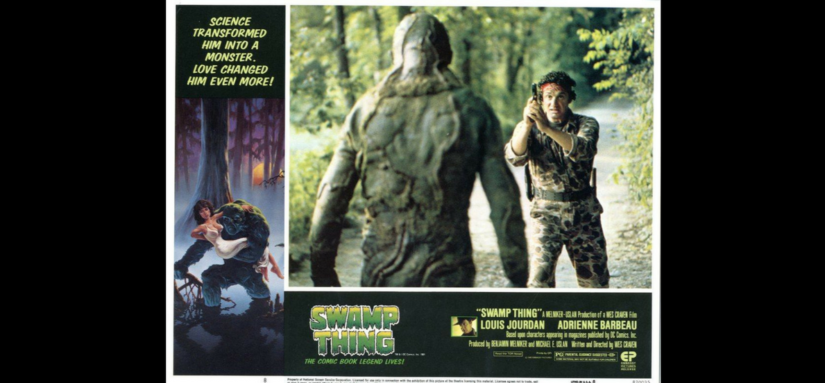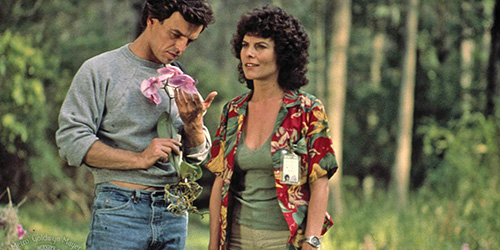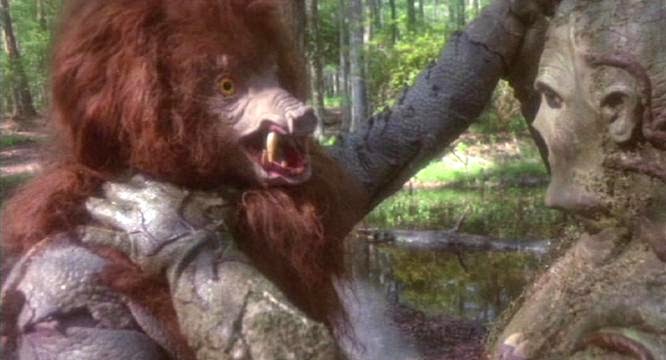“This way or no way
You know I’ll be free
Just like that bluebird
Now, ain’t that just like me?”
“Lazarus” by David Bowie, from the album Blackstar.
***
“Dream the dreams of other men
You will be no ones rival
A distant time
A distant space
That’s where we’re living
A distant time
A distant place
So what you giving?
What you giving?”
“Unthought Known” by Pearl Jam, from the album Backspacer.
The late Roger Ebert concluded his review of Swamp Thing, from writer-director Wes Craven, by playing off some of the film’s dialogue: “There’s beauty in this movie, if you know where to look for it.”
The movie’s leading lady, the buxom Adrienne Barbeau, wasn’t so sure of the film’s redeeming qualities, let alone its beauty. The crew worked a relentlessly paced schedule of 15-hour days. As a result, Barbeau was too exhausted to look at the dailies, going straight to her hotel to get a few winks before the next day of shooting would begin. When the actress finally saw the completed movie, she was mortified—of her wardrobe choices and her hairstyle, among other personal choices—and in her mind, there was no way she would be able to promote Swamp Thing.
Reviews weren’t as harsh as Barbeau’s initial assessment of the finished product. Many of them seemed to comprehend what Craven was aiming for, from the aforementioned Roger Ebert to the New York Times. During an interview on one of the supplements included on the Shout! Factory Blu ray release, the down-to-earth Barbeau laughs at her kneejerk reaction to Swamp Thing, and loosened her stance after more of the complimentary reviews started coming in. She admits that maybe she’d been too critical, or didn’t know enough about genre films to grasp what would and would not work with audiences. This despite being married at the time to horror heavyweight John Carpenter, and having already appeared in classic genre fare such as The Fog and Escape from New York (and in 1982 she would pop up in a segment of the George Romero/Stephen King collaboration Creepshow, the same year Swamp Thing hit theaters).
In fact, it was Carpenter who pushed Barbeau to consider the role of Alice Cable in Swamp Thing, as Carpenter admired the work of Wes Craven. Even though Craven was still two years away from unleashing his razor-clawed Freddy Krueger character on unsuspecting moviegoers with A Nightmare on Elm Street, the young monster maestro had a few gnarly notches on his belt with The Last House on the Left (1972), The Hills Have Eyes (1977), and Deadly Blessing (1981). The actress’ judgment was questionable at worst, overly optimistic at best: when Barbeau read the screenplay for Swamp Thing, she thought it had the potential to be the next Star Wars. Perhaps on paper, left to imagination, the script was epic, but from preproduction and forward, as Craven’s horror-fantasy-sci-fi monster mash-up Swamp Thing began to materialize and take shape in front of rolling cameras, it would be swimming upstream against powerful currents.
Swamp Thing is essentially a retelling of Beauty and the Beast but for ’80s comic-book readers. Deep in the swamps, Dr. Alec Holland (actor Ray Wise) is a scientist experimenting on a formula that could prove beneficial to humankind. It would allow things to grow under harsh conditions and, in the right hands, it might provide a solution to world hunger.
Barbeau’s Alice Cable arrives just in time to meet handsome Dr. Holland, and to learn of his formula’s proprietary benefits. Sparks fly—after all, it’s lonely out in those swamps, and the two are instantly smitten with one another. Alice Cable isn’t the only one privy to the potion and Holland’s plans, as the evil Dr. Arcane (the scene-stealing Louis Jourdan, who behind the scenes, was grieving the recent loss of his son) wants to get his mitts on Holland’s work. Arcane wants what Holland has, and his machine gun-totting men move in like guerillas in the mist. Mayhem ensues, there’s a lab accident, Dr. Holland is disfigured and mutated into “the beast” in our Beauty and the Beast equation, and (grab your popcorn!) Swamp Thing is off to the races.
The Wes Craven who helmed Swamp Thing was not the same polished, seasoned vet who revitalized the comatose corpse of the horror genre by flipping it on its head (along with all the tired tropes) in the ’90s with the Scream franchise. Carpenter and other diehard genre aficionados may have been familiar with Craven in 1982, sure, but in 1982 he wasn’t exactly a household name. While finishing Deadly Blessing, Craven was doing double-duty scouting locations and working on preproduction for Swamp Thing, essentially shepherding two films at the same time, no easy task.
Grueling as that may be, the most formidable foe of Swamp Thing would be its budget, which shrunk significantly from the moment Craven had completed his final draft on the screenplay. Enough of the funds were cut that large chunks of the script had to be omitted (mostly action sequences from the third act). And Craven was constantly being harassed by the powers-that-be to get the film completed ahead of schedule and thus under budget. There was a lot of rushing around and shortcuts taken to please the bean counters. According to Barbeau, many crewmembers would take frequent bathroom breaks and return with a case of the sniffles and a reinvigorated work ethic. Let’s just say it wasn’t the caffeine in their Coke that was putting the pep in their step.
Unquestionably the film suffered because of the budget slashing, in particular the make-up and costume of our plant-based protagonist, the Swamp Thing himself. Only two sets of two suits could be afforded (one pair for actor Ray Wise, and one pair for actor Dick Durock). There are scenes where it doesn’t require much scrutiny from the viewer or even a quick push of the pause button to notice some of the wear and tear of the rubbery, glorified Scuba suit worn by the actors portraying the green mossy monster. (The character design and make-up effects would be vastly improved in time for a sequel and even a live-action TV series).
While Dick Durock was cast to play the Swamp Thing creature, Craven apparently filmed scenes with Ray Wise in the costume, the majority of which were left on the editing room floor because it was too obvious from the size difference when Wise was on the screen in the suit compared to when Durock was playing Swampy. (For the record: there are close-ups of Wise, post-creature transformation, which Craven kept in the film.)
It’s challenging to view the Swamp Thing creature on its cost-cutting budget in a world that has seen drastic advancements in special effects. In this day and age, Swamp Thing reminds me of another relic of yesteryear, the drive-in theater, because this movie would be right at home projected onto an outdoor screen, where the overall experience is part of the charm.
So if we are to examine Swamp Thing under a microscope in 2017, we must do so with some context of the times, both then and now. What matters most, of course, is the plot. Does the story hold up? Did Craven’s take on the character ever measure up to much of anything?
As a child, Craven’s religion forbade him from reading comic books. He wasn’t familiar with the character until he started writing the screenplay. Even if Craven hadn’t fully blossomed as a filmmaker, his raw talent elevated him so he was never a journeyman hack at any point in his career. In hindsight, the sheer notion itself of a Swamp Thing film brought to life by Craven is incredible, like one of those classic “What If” scenarios many of us have pondered as comic book readers. Remember when there was talk of James Cameron helming Spider-Man, the Wachowskis filming Plastic Man, or Tim Burton giving flight to his version of Superman (but with Craven’s take on Swamp Thing likely having 1/50th of any of those budgets, maybe even much less)?
Len Wein, who co-created the Swamp Thing character in the comics (along with Bernie Wrightson), was very diplomatic and charitable when giving his opinion about the film (as seen on another supplemental feature on the Blu ray release). Wein said movie adaptations of comic books work best when the source material is treated seriously and not regarded as “just a comic book”: think Sam Raimi’s Spider-Man or Christopher Nolan’s Batman. Wein enjoyed the first 15 minutes or so of the film, which followed the origin tale rather closely, before distancing itself from the Swamp Thing of the comics.
Len Wein grew up wanting to be a comic book artist, and submitted work regularly to D.C. Comics. The comic book publisher advised him that while his artwork samples might not have been up to snuff by their standards, his writing certainly caught their attention. Wein persevered and D.C. asked him for more stories, to which he gladly obliged, and the rest as they say is history.
As Wein honed and perfected his craft after enjoying an enormously rewarding career as a respected and beloved comic-book writer, he learned that each medium has certain aspects that may work in one but not in the other. The trick is often in the translation.
Blockbuster producer Joel Silver (The Matrix franchise, the Lethal Weapon franchise, the Die Hard franchise) had asked Wein to write a screenplay for Swamp Thing many years after Craven’s movie, and in porting his creation over, Wein had made some significant changes to the origin story and characters himself. Sadly, this film never saw the light of day, but Wein’s work here demonstrated his beliefs: it’s perfectly fine to color outside the lines, as long as the heart of the character remains true. And Wein believed at the heart of Swamp Thing was just that—heart, or man’s own humanity.
Revisiting the film today is bittersweet. Swamp Thing’s creators both passed away this year, Len Wein on September 10th and Bernie Wrightson on March 18th. Director Wes Craven died on August 30, 2015. We were so lucky to have them as they all made huge impacts and were major influences on many fans and storytellers alike. Their iconic stories and characters will live on, of course.
And that there, that’s the secret potion. Movies offer that. Even something that’s “just a comic book” offers that—the ability to give someone a glimpse into their uncorrupted potential or of the things they forgot they had inside their hearts. And to be able to remind someone of who they used to be or what they used to believe in, before everything else snuck in and sunk in, pulling them down in the muck—it may not be providing a cure for world hunger, but it’s not bad.
To change moviegoers or readers’ perspectives, to refresh their perspectives, those are superhuman powers. Whether you’re providing inspiration to the next generation, so they never surrender their dreams and aspirations, or whether you’re helping someone get through just one more day—one day at a time—there’s something magical and noble about all that. What we do with that is up to us, but Wein, Wrightson, and Craven left behind plenty of dreams to be discovered (and rediscovered) by the dreamers still out there among us. Time is precious, but believe me, there will always be time to grow up.
Even after all these years, Craven’s Swamp Thing shows plenty of heart. It’s at turns a goofy (see: the climax with Swampy battling the mutated Dr. Arcane, sporting monster make-up effects with less articulation than an early 80s Chuck E. Cheese birthday mascot), often bizarre (see: one of Dr. Arcane’s henchman being transformed into a troll), occasionally sweet B-movie that’ll whisk you back to your youth. It’s a time capsule from the days of drive-ins, family run video stores, and an era when a lone HBO channel on your TV set was a chance to find beauty in a movie, even one with a title like Swamp Thing.
That is, of course, if you know where to look for it.







Comments are closed.